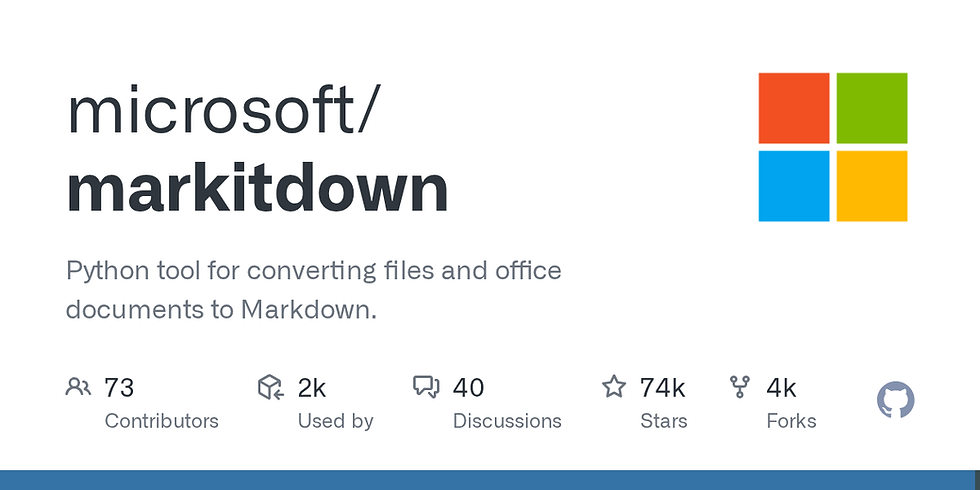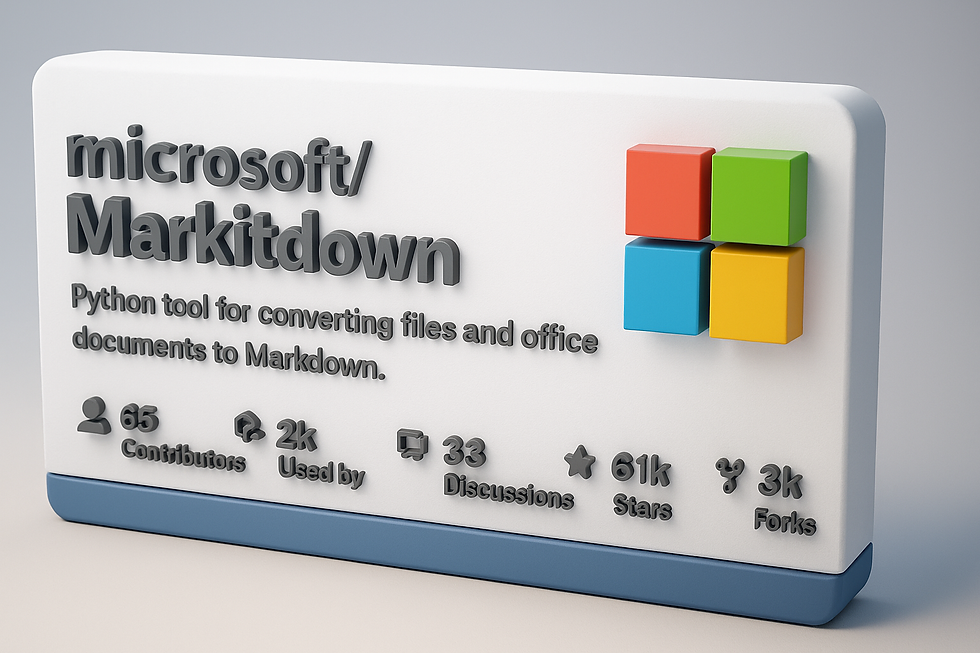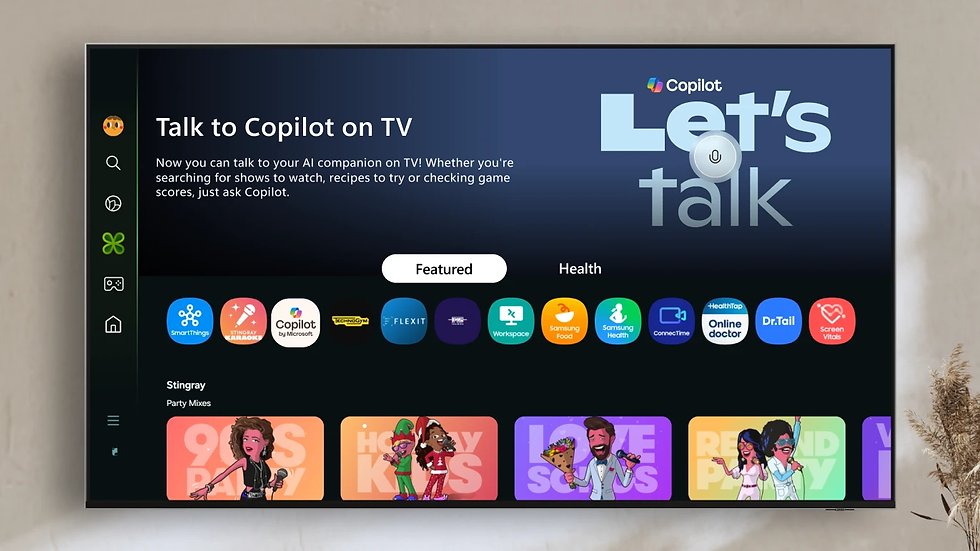Microsoft MarkItDown: Open-Source Tool for Markdown Conversion and AI Document Parsing
- Olivia Johnson

- Sep 15
- 10 min read

A public launch that points to a pragmatic goal
What was released and why it matters
Microsoft publicly announced MarkItDown and published release artifacts on September 15, 2025, and the project repository and tagged builds are available on Microsoft’s GitHub page for MarkItDown. At a glance, MarkItDown is a converter that marries traditional Markdown transformation with machine‑learning (ML)–driven document parsing. That combination aims to move beyond brittle, rule‑based converters by using models to recognize semantic structure and metadata in documents that are messy, inconsistent, or scanned images.
Markdown conversion is the process of turning formatted documents (Word, HTML, PDFs, etc.) into Markdown — a lightweight markup language used widely for documentation, static sites, and content stores. MarkItDown layers ML parsing on top of format conversion so the output is not only syntactically correct Markdown but also retains higher‑level structure such as semantic sections, inferred titles, and author metadata. This can shorten migration projects, improve the fidelity of generated docs, and make content more useful for downstream AI tasks like LLM ingestion or semantic search.
Quick practical takeaway: developers and enterprises can clone the repository, download the binaries or packages from the project’s GitHub releases, and run conversion tests against representative documents to evaluate how ML-backed parsing performs on their content sets. This is an open‑source project intended to be evaluated and extended in public; the repo contains release notes and artifacts to get started quickly.
Insight: MarkItDown is less about replacing Markdown parsers and more about adding a semantic layer that understands documents, which is increasingly valuable when feeding content to AI systems.
Microsoft MarkItDown features for Markdown conversion and AI document parsing

Core conversion plus semantic understanding
At its heart, MarkItDown offers two complementary capabilities: format conversion and semantic parsing. The conversion engine handles common input types — legacy Word documents, HTML pages, PDFs, and rich text — and emits Markdown while keeping document elements such as headings, tables, code blocks, images, and inline formatting intact. It supports configurable output flavors, so teams can adapt the output for documentation engines (like static site generators and documentation frameworks) without extensive post‑processing.
The semantic layer is where MarkItDown departs from conventional converters. Rather than relying only on heuristics for things like “this bold line is a section heading,” the project integrates ML models that detect document elements and infer structure: semantic sections (e.g., Overview, Background, Steps), logical titles, author information, and even tables of contents. This is particularly useful for noisy inputs — scanned PDFs, inconsistent styling across legacy docs, or documents produced by many different authors over time.
Extensibility and developer tooling
MarkItDown is built for developers. The repository and releases include a command‑line interface (CLI) for ad hoc use, as well as SDKs and APIs for programmatic integration. The project provides hooks for custom models and plugin‑based output transforms so teams can slot in domain‑specific classifiers, tailor export templates, or connect outputs to CI/CD pipelines and content management systems.
Key developer conveniences include:
A CLI to convert single files or batches.
An SDK and REST API for automating conversions in pipelines.
Plugin points to integrate custom ML models or format transforms.
These tools make it practical to embed MarkItDown into a documentation migration, nightly ingestion job, or a publish pipeline that feeds downstream LLMs.
Practical enterprise features
Microsoft designed MarkItDown with scale in mind: bulk conversion modes, streaming pipelines for large corpora, and programmatic controls for batch jobs. For enterprises migrating large knowledge bases or feeding content to search and AI systems, MarkItDown promises both the fidelity of format conversion and improved semantic accuracy thanks to ML parsing. The public project invites plugins and model fine‑tuning to meet vertical needs such as legal, healthcare, or developer documentation.
Bold takeaway: MarkItDown targets the intersection of fidelity and semantic understanding, making it useful for migration and AI ingestion tasks where both structure and meaning matter.
References for feature details and analysis are available in the official repo and in industry coverage that highlights the AI parsing capabilities in greater depth (see the press release announcing MarkItDown and a technical feature overview on AI Tech Blog).
Microsoft MarkItDown performance metrics and system requirements

What the releases include and how it performs
The initial release is available as tagged versions that include binaries, source bundles, and release notes on the project’s GitHub releases page. Each release documents feature additions, bug fixes, and model version updates so teams can track changes and regression risks when upgrading.
Independent testing and empirical evaluations referenced by the project show measurable improvements where ML parsing is helpful. An academic evaluation framework commonly used in the document‑understanding community indicates that ML‑assisted parsing yields higher extraction accuracy on benchmark datasets compared with baseline rule‑based converters.
System requirements and runtime considerations
MarkItDown is distributed as source code and as compiled artifacts. For small‑scale conversions or development, it runs comfortably on standard developer machines, VMs, and containers. When you enable ML models for large‑scale inferencing or fine‑tuning, GPU support becomes beneficial for throughput and latency; however, inference on CPUs remains possible for lower volumes.
The release notes enumerate dependencies and recommended runtime configurations. For production deployments, expect typical requirements:
Containerized deployments (Docker) or VM images for isolation.
Optional GPU nodes for model inference (NVIDIA CUDA stacks).
Storage and I/O tuning when converting very large corpora with many embedded assets (images, large tables).
Benchmarks to watch
The project and its community will publish benchmarks comparing:
Parse accuracy (element and field extraction precision/recall).
Throughput (documents per second) under CPU vs GPU.
Resource utilization (memory and CPU/GPU usage per document).
Look for these benchmarks in the repo’s releases and linked research; the press materials point to improved accuracy, but practical deployment tests on representative data are the best way to estimate cost and performance for your use case.
Insight: ML parsing improves accuracy on messy inputs, but it also introduces variability tied to model versions and compute choices — track model updates in releases closely.
For detailed release artifacts and installation guidance, consult the project releases at MarkItDown releases and the initial announcement on Microsoft’s site describing the project’s aims and packaging options: Microsoft’s launch statement.
Availability, licensing, and enterprise adoption
How MarkItDown is being rolled out and what the license means
MarkItDown is available now as an open‑source project on Microsoft’s GitHub. The codebase, issue tracker, and contribution guidelines live in the project repository, and Microsoft calls for community engagement via issues, pull requests, and plugin submissions. The official announcement and artifacts went live on September 15, 2025, which is the first public marker for adoption and experimentation by teams outside Microsoft.
The repo includes a license file and contribution guidance. Because licensing is a legal instrument with fine details, organizations should consult the repository’s LICENSE and contributor documentation to confirm permissions for commercial use, redistribution, and derivative works. The repository itself is the authoritative source for the precise license terms; see the MarkItDown GitHub repository for those files.
Enterprise support and adoption pathways
Although MarkItDown is community‑driven, enterprises will evaluate several factors before adopting it in production:
The maturity of the initial release and the cadence of security patches (watch the GitHub releases).
Availability of commercial support or partnership options (enterprise teams may choose to contract with vendors or consult Microsoft’s enterprise services).
Integration paths for existing CI/CD and content management systems via provided SDKs and connectors.
Industry commentary notes that community projects backed by large vendors often evolve into hybrid models where open‑source remains free but professional support or managed services become available. For now, Microsoft frames MarkItDown as an open project; firms that need guaranteed SLAs should plan for internal support or commercial arrangements.
Roadmap signals
Expect iterative releases and model updates to show up on the releases page. The project’s GitHub repository and the initial press release are the primary places to monitor for security patches, model upgrades, and new conversion features. Community engagement will likely shape the priorities and vertical optimizations that appear in future releases — active contributors can influence parsing heuristics and export templates.
Bold takeaway: MarkItDown is free to clone and test, but production adoption requires governance around licensing, model maintenance, and support expectations — review the repository’s license and track release notes carefully.
For repository artifacts and timeline details, consult the project’s GitHub repo and the official GitHub releases page. The project launch is summarized in Microsoft’s corporate announcement at the September 15 press release.
Comparison and real-world developer impact

How MarkItDown stacks up and where it changes workflows
The principal differentiator for MarkItDown is its ML‑assisted parsing. Traditional Markdown converters focus on deterministic rules: map a paragraph styled as a heading to a Markdown header, convert bold to bold, map tables and lists deterministically. That approach is fast and predictable but brittle when documents are visually noisy, inconsistently authored, or scanned without semantic tags.
MarkItDown introduces models that infer semantic roles and metadata. This approach improves the quality of output for:
Legacy documentation with inconsistent styling.
Scanned PDFs and images that require layout and text recognition.
Large heterogeneous corpora where manual cleanup is costly.
Industry analysis highlights MarkItDown’s niche: combining conversion fidelity with semantic understanding to prepare content for AI pipelines and enterprise migration projects. Coverage in outlets like InfoWorld examines how this positioning may attract teams that previously used lightweight converters but lacked satisfactory results when feeding content to search systems or LLMs; see the InfoWorld analysis that examines MarkItDown’s place in the market and practical trade-offs.
Trade-offs to evaluate
Machine learning brings clear benefits in ambiguous contexts, but it also introduces trade-offs:
Compute and infrastructure: ML models can increase resource needs, especially at scale or when GPU acceleration is used.
Model stewardship: teams must track model versions, handle drift, and fine‑tune models for domain specificity.
Determinism and auditing: rule‑based converters are predictable; ML outputs may need manual validation for compliance or legal content.
Organizations should balance accuracy gains against operational costs. For example, a legal firm may accept higher compute costs for better extraction accuracy across thousands of legacy contracts, while a small open‑source documentation project might prioritize a simpler, deterministic converter for speed and simplicity.
Insight: The best candidates for MarkItDown are teams that need semantic accuracy at scale or want to prepare content for downstream AI tasks that depend on structured inputs.
Developer workflow impact and community effect
Developers get practical tools: a CLI for batch runs, SDKs for embedding conversions into CI/CD, and plugin hooks for custom logic. This changes how teams think about documentation pipelines: conversions can be automated in a build step, normalized for consistency, and augmented with metadata tags that improve search and LLM responses.
The open‑source nature encourages community contributions — developers can add domain‑specific parsers, fine‑tune models for industry jargon, or create export templates for particular doc sites. Early adopters who contribute back can help shape model behavior and parsers to meet vertical needs, which accelerates maturation of the project for everyone.
For deeper comparisons and empirical benchmarks, reference the foundational parsing evaluation literature on arXiv and platform coverage such as the InfoWorld analysis, which place MarkItDown in context with competing tools.
FAQ: Microsoft MarkItDown — Markdown conversion and AI document parsing questions

Common questions and concise answers
Q: What is Microsoft MarkItDown and when was it released? A: MarkItDown is an open‑source tool that combines Markdown conversion with AI document parsing; Microsoft announced the public release on September 15, 2025 as noted in the launch press release.
Q: How do I get and install MarkItDown? A: Clone or download the project from the official GitHub repository and check the releases page for tagged builds, installation instructions, and platform artifacts.
Q: What license applies to MarkItDown? A: The project is published as open‑source on Microsoft’s GitHub; consult the repository’s LICENSE and contribution files for exact terms that govern commercial use and contributions — see the project repo for license details.
Q: What should I expect for performance and extraction accuracy? A: Early evaluations and referenced research indicate ML parsing improves extraction accuracy compared to rule‑based baselines; specific metrics depend on your datasets and deployment hardware — look for benchmarks in the repo and in related evaluation literature like the arXiv parsing benchmarks.
Q: Do I need GPUs to run MarkItDown? A: Not for small‑scale use. GPU acceleration helps with large‑scale inference or training. The project supports CPU execution for lighter workloads; check the release notes for recommended hardware configurations on the GitHub releases page.
Q: Can MarkItDown integrate with CI/CD pipelines or LLM workflows? A: Yes. The project provides CLI and SDK hooks designed for integration with CI/CD systems, content pipelines, and LLM ingestion workflows. See the repository for API docs and plugin examples at MarkItDown’s GitHub.
Q: Where can I find benchmarks, demos, and community discussion? A: Official benchmarks and demos will appear in the project releases and the GitHub issue tracker; press coverage and technical analyses provide secondary context. Start with the GitHub releases and the repository itself for demos and discussions.
Q: How much work is required to adapt MarkItDown to a vertical domain (e.g., legal or medical)? A: Adapting to a vertical typically involves fine‑tuning models on domain examples, adding parser heuristics or templates, and creating export transforms. The project’s plugin points and model hooks are designed to make this practical; experiment with a representative subset of documents to gauge effort.
Looking ahead: what MarkItDown signals for document conversion and AI workflows
A practical, community‑driven step toward smarter content pipelines
MarkItDown brings machine learning into a mainstream conversion tool backed by a major vendor and released into the open. In the coming months and years, expect the project to evolve in a few observable ways. First, community uptake will drive model refinements and a library of domain plugins — the most active verticals (developer docs, legal, enterprise knowledge bases) will likely produce templates and tuned models that accelerate adoption. Second, benchmark transparency and release cadence will determine how quickly enterprises can trust the tool in production; clear regressions and reproducible tests in the repo will be critical signals for adoption.
There are trade‑offs to acknowledge. ML parsing improves extraction on noisy inputs but increases the operational surface area: compute costs, model versioning, and the need for human validation in regulated contexts. Organizations considering MarkItDown should run representative pilot projects that measure conversion fidelity, processing time, and total cost of ownership before committing to large migrations.
What opportunities does MarkItDown open? For documentation teams, it means fewer manual edits when migrating legacy content and richer metadata for search and LLMs. For platform builders, it offers a way to normalize repositories for downstream AI tasks, improving retrieval‑augmented generation and knowledge search results. For developers, it opens an opportunity to contribute parsing heuristics and share vertical expertise back into the community.
Insight: The story of MarkItDown will be written as much by its early adopters as by its original authors — real value will come from shared benchmarks, plugins, and model snapshots that make ML parsing repeatable and auditable.
If you’re evaluating MarkItDown today, a pragmatic path is to set up a small pilot, convert a representative dataset, and compare outputs with your current tools on both accuracy and cost. Watch the project’s GitHub releases and community channels for model updates, and be ready to participate — the open‑source model here is also the project’s chief accelerator.
In sum, MarkItDown is a meaningful step toward structurally smarter conversions: it doesn’t promise a perfect, one‑size‑fits‑all solution, but it does offer a practical platform to reduce manual cleanup, prepare documents for AI systems, and build a community of contributors who can refine models and templates for real‑world needs.


